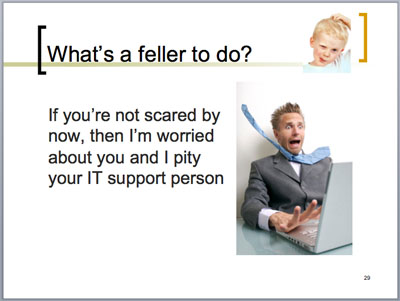For those who missed the IT security roundtable April 9, it’s comforting to know that presenter Harvard Townsend (K-State’s chief information security officer) diligently documents the details in his PowerPoint files. The Safe(r) Web Browsing presentation (50-slide PowerPoint) that’s now online serves as a realistic roadmap of the latest dangers and defenses for K-Staters who want to be safer-than-sorry when browsing the Web.
As Townsend has said before, “The scary thing is you don’t even have to click on anything – just visiting a site with malicious code can initiate a download that installs malware on your computer without you knowing it.”

The agenda starts with “The Internet is a bad neighborhood” and covers:
- The dangers of web browsing
- Helpful features built into web browsers
- Tools you can add to your web browsers
- Trend Micro is your friend
- Miscellany cautions/tips/tricks
Take-away points
- The Safe(r) Web Browsing presentation shows-and-tells how to recognize bad web addresses (URLs) online, in e-mail, searches, and other links.
- Search-engine poisoning happens when top services such as Google “are tricked into presenting a malicious link in the top 10 results for popular searches” and “13 percent of Google searches for popular or trendy topics yield malicious links.”
- Watch out for bad URLs hidden by shortening services like TinyURL.com, Bit.ly, and CloakedLink.com.
- Use the “country code definitions” at www.iana.org/domains/root/db/index.html to check where websites are really hosted (example: .ch = China).
- It’s essential to keep good security tools and setups on your computer (see the helpful features, tools, and cautions/tips/tricks).
Townsend’s conclusions
- There’s no way to be 100 percent secure surfing the Web these days.
- Use a multi-faceted approach to reduce your risk (browser security features, browser add-ons, Trend Micro security software, educate yourself).
- These tools and techniques make your browsing experience less convenient and may frustrate you at times, but they are necessary in today’s hostile online climate.
- Think before you click!
For more details, see the April 6 news article and the April 9 Safe(r) Web Browsing PowerPoint presentation.